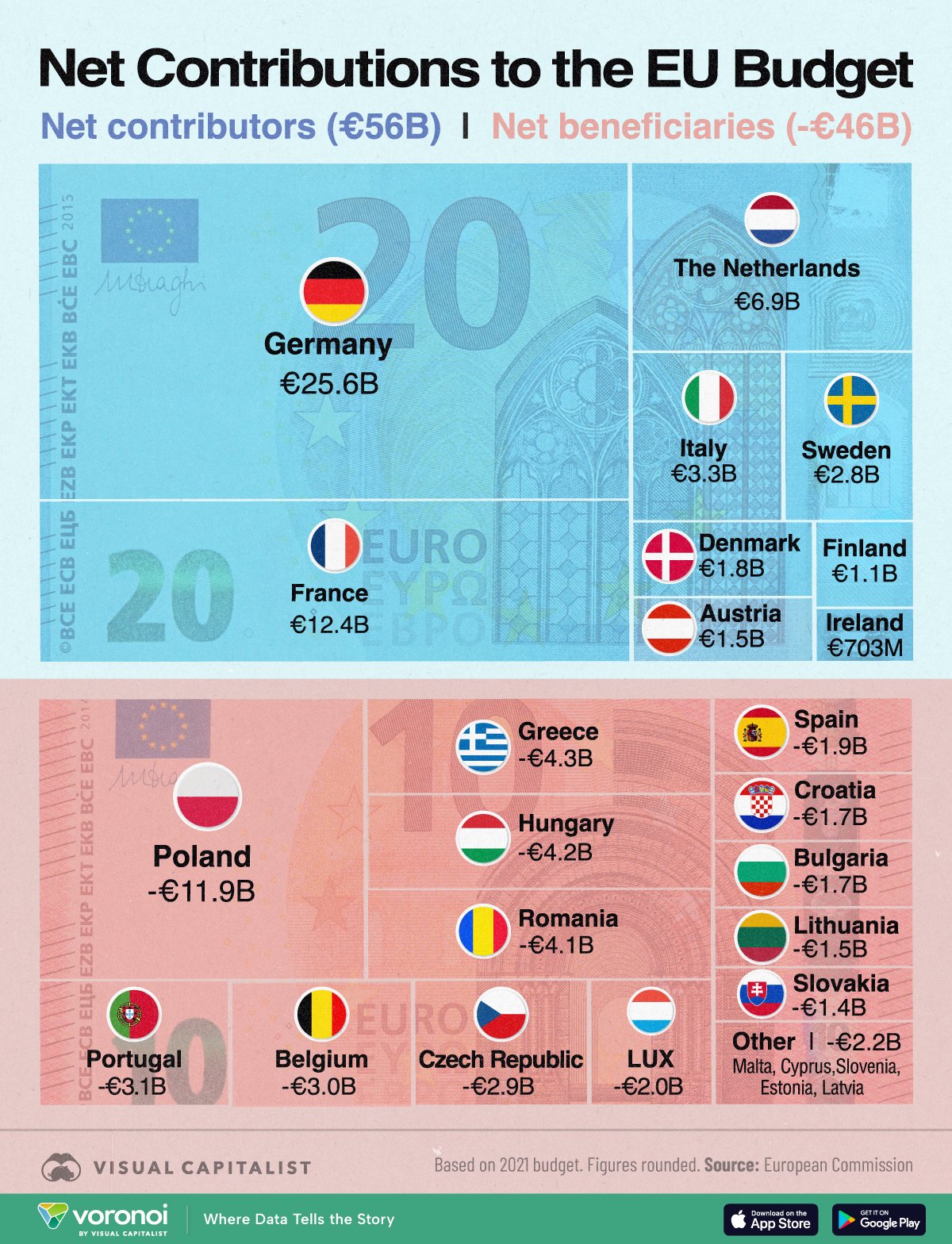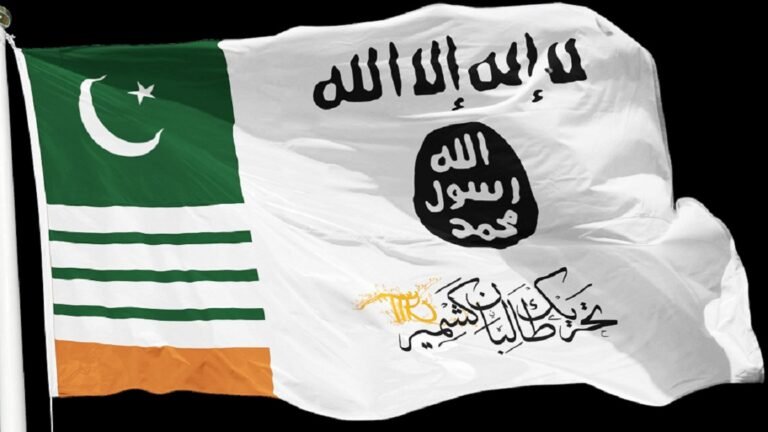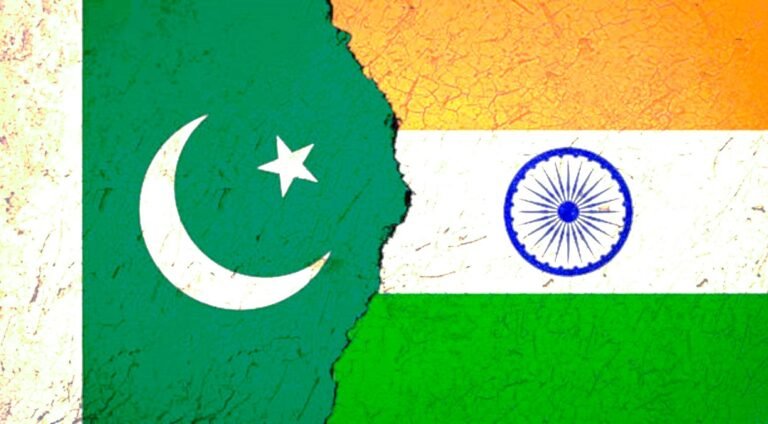Who Contributes the Most to the EU Budget? The European Union (EU) budget, a key tool for funding shared projects and ensuring cohesion across its member states, relies on financial contributions from each member based on their economic size and Gross National Income (GNI). This system promotes economic growth and cohesion, with wealthier countries contributing more to support less affluent ones. In 2021, the distribution of contributions highlighted significant imbalances between net contributors and net beneficiaries, with notable effects on EU dynamics, including Brexit.
Key Data on Net Contributions in 2021
Based on the data from the European Commission, visualized through Statista, the following key points emerge regarding the EU budget contributions for 2021:
- Germany and France were the largest contributors to the EU budget. Germany, the largest economy in Europe, contributed a net €25.57 billion, followed by France at €12.38 billion. These two countries together accounted for a significant share of the overall EU budget.
- The Netherlands, Italy, Sweden, Denmark, Austria, Finland, and Ireland were other notable net contributors, with the Netherlands contributing €6.93 billion, Italy €3.34 billion, and Sweden €2.83 billion.
- Smaller contributors, such as Malta, Cyprus, Slovenia, Estonia, and Latvia, were net beneficiaries, with these countries receiving more from the EU budget than they contributed.
Net Beneficiaries vs. Net Contributors
The data highlights a clear divide between net contributors (countries that contribute more to the EU than they receive) and net beneficiaries (countries that receive more than they contribute). Nine countries were net contributors in 2021, and the remaining 18 were net beneficiaries.
Net Contributors:
- Germany (€25.57 billion)
- France (€12.38 billion)
- Netherlands (€6.93 billion)
- Italy (€3.34 billion)
- Sweden (€2.83 billion)
- Denmark (€1.77 billion)
- Austria (€1.54 billion)
- Finland (€1.11 billion)
- Ireland (€0.70 billion)
Net Beneficiaries:
- Malta (-€0.014 billion)
- Cyprus (-€0.172 billion)
- Slovenia (-€0.386 billion)
- Estonia (-€0.729 billion)
- Latvia (-€0.860 billion)
- Others include Eastern and Southern European countries such as Poland, Greece, and Portugal, who typically receive more from the EU than they contribute.
EU Budget Distribution and Cohesion
The EU budget is designed not only to fund day-to-day EU operations but also to support the development of regions that are economically less prosperous. This redistribution of funds helps ensure that wealthier EU countries support poorer ones, facilitating cohesion and overall growth across the union.
For instance, regions in Eastern Europe, such as Poland, Romania, and Bulgaria, typically receive more funding than they contribute, which aids in closing the development gap between East and West. These funds support infrastructure development, agricultural subsidies, and other projects designed to reduce regional disparities.
Brexit and the UK’s Contribution to the EU Budget
The issue of net contributions was central to the Brexit debate. The UK, traditionally a net contributor to the EU budget, faced growing criticism over its contributions, particularly after the 2008 global financial crisis, which saw an increase in the UK’s financial obligations. The decision to leave the EU was partly driven by the belief that the UK could redirect its contributions to fund domestic priorities instead.
Data visualized in this report indicates that the UK’s financial contribution had increased notably after the 2008 crisis, contributing significantly to the EU’s economic recovery efforts. The UK’s departure has left a gap in contributions, which the EU has had to adjust to by reallocating resources and adjusting its fiscal strategies.
Public Opinion on the EU’s Financial Mechanisms
Public opinion on EU membership, particularly concerning financial contributions, varies significantly across member states. Polls conducted by Allianz Research in 2024 show that there are significant differences in the perceived benefits of EU membership among EU citizens. In countries like Spain and Austria, a majority of respondents believe their countries benefit more than they lose from being in the EU. However, in countries like France and Germany, a larger proportion of the population feels that their country contributes more than it gains from EU membership.
This discrepancy often fuels debates about the EU’s financial structure and whether certain countries are disproportionately benefiting from the union. The larger net contributors, such as Germany and France, may feel the weight of financing the EU’s broader goals, while net beneficiaries are more likely to view EU membership positively due to the financial support they receive.
Conclusion: The EU Budget as a Tool for Cohesion
The EU budget serves as a critical tool for fostering cohesion and balancing economic disparities between member states. While the larger economies like Germany, France, and the Netherlands contribute more than they receive, they also play a crucial role in funding projects that benefit the entire EU. For smaller and less economically developed countries, the EU budget provides significant financial support that helps close the gap in development and prosperity.
However, the distribution of contributions and benefits also raises political and social challenges, with countries like the UK citing the imbalance as one of the reasons for leaving the EU. As the union evolves, the EU faces the challenge of balancing the financial contributions from its member states with the need for cohesion and solidarity, while also addressing the concerns of those who feel their countries bear an unfair share of the financial burden.
Further Considerations
- Post-Brexit adjustments: With the UK’s departure, the EU needs to find new ways to address the financial gap left by the UK’s contributions. This might mean greater reliance on the contributions of the largest member states, or adjustments to the EU’s fiscal strategy.
- Economic recovery post-pandemic: The EU budget will likely continue to focus on recovery from the COVID-19 pandemic, with funds allocated for rebuilding economies, healthcare systems, and infrastructure across Europe.
In summary, understanding the contributions and financial dynamics of the EU is essential for comprehending the union’s internal structure and the ongoing debates about its future. The disparities in contributions highlight both the successes and challenges of European integration.









